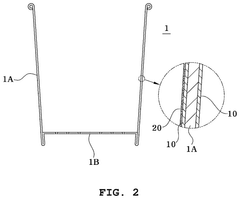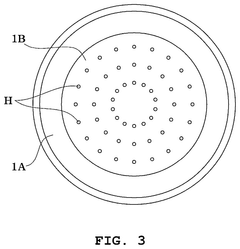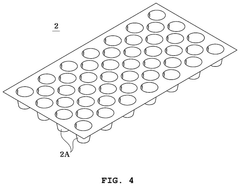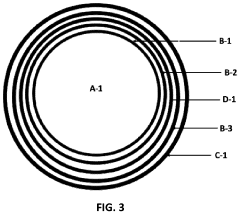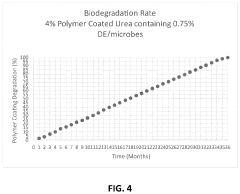How Biodegradable Plastics Improve Soil Fertility
MAY 15, 20259 MIN READ
Generate Your Research Report Instantly with AI Agent
Patsnap Eureka helps you evaluate technical feasibility & market potential.
Biodegradable Plastics and Soil Fertility: Overview
Biodegradable plastics have emerged as a promising solution to address the growing environmental concerns associated with conventional plastics. These innovative materials are designed to decompose naturally in the environment, offering a potential pathway to reduce plastic pollution and enhance soil fertility. The intersection of biodegradable plastics and soil health presents a fascinating area of study, with implications for sustainable agriculture and ecosystem management.
The concept of biodegradable plastics dates back to the 1980s, but recent advancements in material science and biotechnology have accelerated their development and application. These plastics are typically derived from renewable resources such as corn starch, vegetable oils, and cellulose, or synthesized by bacteria from various carbon sources. Unlike conventional plastics that persist in the environment for hundreds of years, biodegradable plastics can break down into natural compounds within months to years, depending on environmental conditions.
The potential of biodegradable plastics to improve soil fertility lies in their ability to decompose into organic matter, which can be beneficial for soil structure and microbial activity. As these materials break down, they release nutrients that can be absorbed by plants and soil organisms, potentially enhancing soil fertility and supporting plant growth. This process mimics the natural cycle of organic matter decomposition, integrating the disposal of plastic waste with soil enrichment.
However, the relationship between biodegradable plastics and soil fertility is complex and multifaceted. The rate and products of decomposition can vary significantly depending on the specific type of biodegradable plastic, soil conditions, and environmental factors such as temperature and moisture. Some biodegradable plastics may leave residues or break down into compounds that could temporarily alter soil pH or microbial communities.
Research in this field is ongoing, with scientists exploring various aspects of biodegradable plastic degradation in soil environments. Studies are examining the impact on soil structure, nutrient cycling, microbial diversity, and plant growth. The goal is to develop biodegradable plastics that not only reduce environmental pollution but also contribute positively to soil health and agricultural productivity.
As we delve deeper into this topic, it's important to consider the broader implications of integrating biodegradable plastics into agricultural practices. This includes evaluating their life cycle impacts, economic feasibility, and potential to address global challenges such as food security and climate change mitigation. The development of biodegradable plastics that enhance soil fertility represents a convergence of materials science, environmental engineering, and agricultural research, highlighting the interdisciplinary nature of sustainable solutions.
The concept of biodegradable plastics dates back to the 1980s, but recent advancements in material science and biotechnology have accelerated their development and application. These plastics are typically derived from renewable resources such as corn starch, vegetable oils, and cellulose, or synthesized by bacteria from various carbon sources. Unlike conventional plastics that persist in the environment for hundreds of years, biodegradable plastics can break down into natural compounds within months to years, depending on environmental conditions.
The potential of biodegradable plastics to improve soil fertility lies in their ability to decompose into organic matter, which can be beneficial for soil structure and microbial activity. As these materials break down, they release nutrients that can be absorbed by plants and soil organisms, potentially enhancing soil fertility and supporting plant growth. This process mimics the natural cycle of organic matter decomposition, integrating the disposal of plastic waste with soil enrichment.
However, the relationship between biodegradable plastics and soil fertility is complex and multifaceted. The rate and products of decomposition can vary significantly depending on the specific type of biodegradable plastic, soil conditions, and environmental factors such as temperature and moisture. Some biodegradable plastics may leave residues or break down into compounds that could temporarily alter soil pH or microbial communities.
Research in this field is ongoing, with scientists exploring various aspects of biodegradable plastic degradation in soil environments. Studies are examining the impact on soil structure, nutrient cycling, microbial diversity, and plant growth. The goal is to develop biodegradable plastics that not only reduce environmental pollution but also contribute positively to soil health and agricultural productivity.
As we delve deeper into this topic, it's important to consider the broader implications of integrating biodegradable plastics into agricultural practices. This includes evaluating their life cycle impacts, economic feasibility, and potential to address global challenges such as food security and climate change mitigation. The development of biodegradable plastics that enhance soil fertility represents a convergence of materials science, environmental engineering, and agricultural research, highlighting the interdisciplinary nature of sustainable solutions.
Market Demand Analysis
The market demand for biodegradable plastics that improve soil fertility is experiencing significant growth, driven by increasing environmental concerns and the need for sustainable agricultural practices. This innovative technology addresses two critical issues simultaneously: plastic pollution and soil degradation, making it highly attractive to various stakeholders in the agricultural and environmental sectors.
In the agricultural industry, there is a growing recognition of the importance of soil health for sustainable food production. Farmers and agribusinesses are actively seeking solutions that can enhance soil fertility while reducing the environmental impact of traditional farming practices. Biodegradable plastics that contribute to soil improvement offer a compelling value proposition, potentially increasing crop yields while minimizing the use of chemical fertilizers.
The horticulture and landscaping sectors also present substantial market opportunities for these biodegradable plastics. As urban green spaces and home gardening continue to gain popularity, there is an increasing demand for eco-friendly products that can support plant growth and soil health. Products such as biodegradable plant pots, mulch films, and weed control mats that decompose into soil-enriching compounds are likely to see strong consumer interest.
Environmental regulations and government initiatives aimed at reducing plastic waste and promoting sustainable agriculture are further driving market demand. Many countries have implemented or are considering policies that encourage the use of biodegradable materials in agriculture and horticulture. This regulatory landscape is creating a favorable market environment for biodegradable plastics with soil-improving properties.
The packaging industry, particularly for agricultural and horticultural products, represents another significant market segment. As consumers become more environmentally conscious, there is growing pressure on businesses to adopt sustainable packaging solutions. Biodegradable plastics that can safely decompose in soil and contribute to its fertility offer an attractive alternative to conventional plastic packaging.
Market analysis indicates that the global biodegradable plastics market is projected to grow substantially in the coming years, with a significant portion of this growth attributed to agricultural and soil-related applications. The Asia-Pacific region is expected to be a key growth market, driven by the large agricultural sectors in countries like China and India, coupled with increasing environmental awareness and supportive government policies.
However, market penetration faces challenges such as higher production costs compared to conventional plastics and the need for consumer education about the benefits and proper use of these materials. Overcoming these barriers will be crucial for realizing the full market potential of biodegradable plastics that improve soil fertility.
In the agricultural industry, there is a growing recognition of the importance of soil health for sustainable food production. Farmers and agribusinesses are actively seeking solutions that can enhance soil fertility while reducing the environmental impact of traditional farming practices. Biodegradable plastics that contribute to soil improvement offer a compelling value proposition, potentially increasing crop yields while minimizing the use of chemical fertilizers.
The horticulture and landscaping sectors also present substantial market opportunities for these biodegradable plastics. As urban green spaces and home gardening continue to gain popularity, there is an increasing demand for eco-friendly products that can support plant growth and soil health. Products such as biodegradable plant pots, mulch films, and weed control mats that decompose into soil-enriching compounds are likely to see strong consumer interest.
Environmental regulations and government initiatives aimed at reducing plastic waste and promoting sustainable agriculture are further driving market demand. Many countries have implemented or are considering policies that encourage the use of biodegradable materials in agriculture and horticulture. This regulatory landscape is creating a favorable market environment for biodegradable plastics with soil-improving properties.
The packaging industry, particularly for agricultural and horticultural products, represents another significant market segment. As consumers become more environmentally conscious, there is growing pressure on businesses to adopt sustainable packaging solutions. Biodegradable plastics that can safely decompose in soil and contribute to its fertility offer an attractive alternative to conventional plastic packaging.
Market analysis indicates that the global biodegradable plastics market is projected to grow substantially in the coming years, with a significant portion of this growth attributed to agricultural and soil-related applications. The Asia-Pacific region is expected to be a key growth market, driven by the large agricultural sectors in countries like China and India, coupled with increasing environmental awareness and supportive government policies.
However, market penetration faces challenges such as higher production costs compared to conventional plastics and the need for consumer education about the benefits and proper use of these materials. Overcoming these barriers will be crucial for realizing the full market potential of biodegradable plastics that improve soil fertility.
Current Challenges in Biodegradable Plastics
Despite the promising potential of biodegradable plastics in improving soil fertility, several significant challenges currently hinder their widespread adoption and effectiveness. One of the primary obstacles is the inconsistent degradation rates of these materials in different environmental conditions. Soil type, temperature, moisture levels, and microbial activity can all significantly impact the breakdown process, leading to unpredictable decomposition timelines and potentially incomplete degradation.
Another major challenge lies in the balance between durability and biodegradability. While these plastics need to be sturdy enough for their intended use, they must also break down efficiently in soil environments. Achieving this delicate balance often results in compromises that can affect either the product's performance or its ability to degrade effectively.
The production cost of biodegradable plastics remains a significant barrier to their widespread adoption. Currently, these materials are generally more expensive to manufacture than conventional plastics, which can deter both producers and consumers from embracing them. This cost factor also impacts the economic viability of using biodegradable plastics in large-scale agricultural applications.
There are also concerns regarding the potential release of microplastics during the degradation process. As biodegradable plastics break down, they may release small plastic particles that could accumulate in the soil, potentially causing long-term environmental issues. The impact of these microplastics on soil ecosystems and crop health is not yet fully understood and requires further research.
The lack of standardized testing methods and certification processes for biodegradable plastics poses another challenge. Without consistent standards, it becomes difficult to compare different products and ensure their environmental claims are valid. This uncertainty can lead to skepticism among consumers and regulators, slowing the adoption of these materials.
Additionally, there are concerns about the potential for biodegradable plastics to introduce harmful additives or byproducts into the soil during decomposition. Some additives used to enhance the properties of these plastics may have unintended consequences on soil chemistry or microbial communities. Ensuring the safety and compatibility of all components with soil ecosystems is crucial but challenging.
Lastly, the integration of biodegradable plastics into existing waste management systems presents logistical challenges. These materials often require specific conditions for optimal degradation, which may not be met in standard composting facilities or landfills. Developing appropriate infrastructure and processes to handle biodegradable plastics at scale is a significant hurdle that needs to be addressed for their successful implementation in improving soil fertility.
Another major challenge lies in the balance between durability and biodegradability. While these plastics need to be sturdy enough for their intended use, they must also break down efficiently in soil environments. Achieving this delicate balance often results in compromises that can affect either the product's performance or its ability to degrade effectively.
The production cost of biodegradable plastics remains a significant barrier to their widespread adoption. Currently, these materials are generally more expensive to manufacture than conventional plastics, which can deter both producers and consumers from embracing them. This cost factor also impacts the economic viability of using biodegradable plastics in large-scale agricultural applications.
There are also concerns regarding the potential release of microplastics during the degradation process. As biodegradable plastics break down, they may release small plastic particles that could accumulate in the soil, potentially causing long-term environmental issues. The impact of these microplastics on soil ecosystems and crop health is not yet fully understood and requires further research.
The lack of standardized testing methods and certification processes for biodegradable plastics poses another challenge. Without consistent standards, it becomes difficult to compare different products and ensure their environmental claims are valid. This uncertainty can lead to skepticism among consumers and regulators, slowing the adoption of these materials.
Additionally, there are concerns about the potential for biodegradable plastics to introduce harmful additives or byproducts into the soil during decomposition. Some additives used to enhance the properties of these plastics may have unintended consequences on soil chemistry or microbial communities. Ensuring the safety and compatibility of all components with soil ecosystems is crucial but challenging.
Lastly, the integration of biodegradable plastics into existing waste management systems presents logistical challenges. These materials often require specific conditions for optimal degradation, which may not be met in standard composting facilities or landfills. Developing appropriate infrastructure and processes to handle biodegradable plastics at scale is a significant hurdle that needs to be addressed for their successful implementation in improving soil fertility.
Existing Soil Enhancement Solutions
01 Biodegradable plastics improving soil fertility
Certain biodegradable plastics can be formulated to enhance soil fertility when they decompose. These materials release nutrients and organic matter into the soil, promoting microbial activity and improving soil structure. This can lead to better water retention and nutrient availability for plants, ultimately enhancing overall soil health and fertility.- Biodegradable plastics improving soil fertility: Certain biodegradable plastics can be formulated to enhance soil fertility when they decompose. These materials release nutrients and organic matter into the soil, promoting microbial activity and improving soil structure. This can lead to better water retention, increased nutrient availability, and overall improved soil health.
- Soil microorganism interaction with biodegradable plastics: Research focuses on the interaction between soil microorganisms and biodegradable plastics. Some formulations can stimulate beneficial microbial growth, enhancing nutrient cycling and organic matter decomposition. This interaction can potentially accelerate the biodegradation process while simultaneously improving soil quality.
- Biodegradable plastic mulch films for agriculture: Biodegradable plastic mulch films are being developed for agricultural use. These films can help conserve soil moisture, suppress weeds, and regulate soil temperature. As they degrade, they contribute organic matter to the soil, potentially improving its fertility and structure over time.
- Controlled-release fertilizers in biodegradable plastics: Biodegradable plastics can be engineered to incorporate controlled-release fertilizers. As the plastic degrades, it slowly releases nutrients into the soil, providing a sustained source of fertility. This approach can reduce nutrient leaching and improve fertilizer efficiency while also addressing plastic waste concerns.
- Biodegradable plastics as soil conditioners: Some biodegradable plastics are specifically designed to act as soil conditioners. These materials can improve soil structure, water retention, and aeration as they break down. They may also help in reducing soil compaction and erosion, contributing to overall soil health and fertility.
02 Soil microorganism interaction with biodegradable plastics
Research focuses on the interaction between soil microorganisms and biodegradable plastics. Some biodegradable materials can stimulate beneficial microbial populations, leading to improved soil ecosystem functioning. This interaction can accelerate the decomposition process of the plastics while simultaneously enhancing soil microbial diversity and activity.Expand Specific Solutions03 Biodegradable plastic mulch films for agriculture
Biodegradable plastic mulch films are being developed for agricultural applications. These films can help conserve soil moisture, suppress weeds, and regulate soil temperature. As they degrade, they contribute organic matter to the soil, potentially improving its fertility and structure over time.Expand Specific Solutions04 Controlled-release fertilizers in biodegradable plastics
Incorporating controlled-release fertilizers into biodegradable plastics is an emerging technology. This combination allows for the gradual release of nutrients as the plastic degrades, providing a sustained source of fertility to the soil. This approach can reduce nutrient leaching and improve fertilizer efficiency.Expand Specific Solutions05 Biodegradable plastics as soil amendments
Some biodegradable plastics are being designed specifically as soil amendments. These materials can improve soil physical properties, such as water holding capacity and aeration, while also providing a carbon source for soil microorganisms. As they break down, they can contribute to the formation of soil organic matter, enhancing long-term soil fertility.Expand Specific Solutions
Key Industry Players
The biodegradable plastics market for soil fertility improvement is in its growth phase, with increasing demand driven by environmental concerns and sustainable agriculture practices. The market size is expanding rapidly, projected to reach several billion dollars globally in the coming years. Technologically, the field is advancing but still evolving, with varying levels of maturity among key players. Companies like Radical Plastics, BioLogiQ, and LG Chem are at the forefront, developing innovative biodegradable plastic solutions. Research institutions such as Cornell University and the Chinese Academy of Sciences are contributing significant advancements. Collaborations between industry leaders like PTT Global Chemical and academic institutions are accelerating progress, while specialized firms like Pursell Agri-Tech focus on targeted applications in agriculture, indicating a diverse and competitive landscape.
Radical Plastics, Inc.
Technical Solution: Radical Plastics has developed a proprietary technology that transforms conventional plastics into biodegradable materials. Their approach involves incorporating a naturally occurring mineral catalyst into the plastic during manufacturing. This catalyst triggers the biodegradation process when the plastic comes into contact with microbes in soil, marine, or composting environments. The resulting material breaks down into biomass, CO2, and water, leaving no microplastics behind. This technology can be applied to various plastic types, including polyethylene and polypropylene, without compromising the material's original properties or performance.
Strengths: Versatile application across various plastic types; maintains original material properties; complete biodegradation without microplastic residue. Weaknesses: Potential higher production costs; may require specific environmental conditions for optimal biodegradation.
PTT Global Chemical Plc
Technical Solution: PTT Global Chemical has developed BioPBS (Bio-based Polybutylene Succinate), a biodegradable plastic derived from renewable resources. This material is produced through the polymerization of succinic acid and 1,4-butanediol, both of which can be obtained from bio-based feedstocks. BioPBS offers excellent biodegradability in various environments, including soil and compost. When disposed of in soil, it breaks down into natural substances that can be assimilated by microorganisms, potentially enhancing soil fertility. The company has also focused on optimizing the material's properties to ensure it meets performance requirements for various applications while maintaining its biodegradability.
Strengths: Derived from renewable resources; versatile applications; enhances soil microbial activity. Weaknesses: May have limited mechanical properties compared to conventional plastics; production costs could be higher.
Core Innovations in Bioplastics
Natural biodegradation functional seedling paper pots and seedbeds
PatentPendingUS20240357975A1
Innovation
- A biodegradable seedling paper pot with a paper member coated with an acrylic emulsion resin and a biodegradable composition containing black mica, activated carbon, detoxified sulfur, minerals, and liquid microorganisms, which maintains shape and provides nutrients through controlled biodegradation over 3-4 months, eliminating the need for separate fertilization and reducing labor.
Biodegradable coatings, coated particles, and methods of making same
PatentPendingUS20240217891A1
Innovation
- A coating solution incorporating a microbial consortium that degrades the polymer-based layer, ensuring the polymer is reduced to carbon dioxide and water after the particle has delivered nutrients or facilitated germination, with the consortium protected by the polymer layers to maintain effectiveness in various environments.
Environmental Impact Assessment
The environmental impact assessment of biodegradable plastics in soil fertility improvement reveals both positive and negative effects. On the positive side, these plastics can significantly reduce long-term plastic pollution in soil ecosystems. As they decompose, they leave behind fewer persistent microplastics compared to conventional plastics, potentially mitigating the accumulation of harmful particles in agricultural soils.
Furthermore, the breakdown of biodegradable plastics can contribute organic matter to the soil, potentially enhancing its structure and water retention capabilities. This process may lead to improved soil fertility over time, particularly in areas where organic matter content is low. Some biodegradable plastics are designed to release nutrients as they degrade, which could serve as a slow-release fertilizer, benefiting plant growth and soil microbial activity.
However, the environmental impact is not entirely positive. The degradation process of these plastics can temporarily alter soil pH levels, potentially affecting soil chemistry and microbial communities. This pH fluctuation may impact nutrient availability and plant growth in the short term, requiring careful management during the transition period.
Additionally, the breakdown of biodegradable plastics may release microplastics during the degradation process, albeit at lower levels than conventional plastics. These microplastics, though less persistent, can still have short-term effects on soil ecosystems and potentially enter the food chain.
The production of biodegradable plastics also needs consideration in the environmental impact assessment. While they offer benefits in soil applications, their manufacturing process may have a higher carbon footprint compared to some conventional plastics, depending on the feedstock and production methods used.
The impact on soil biodiversity is another crucial aspect to evaluate. Initial studies suggest that biodegradable plastics may support a more diverse soil microbiome compared to conventional plastics. However, long-term effects on soil fauna and flora require further investigation to ensure no unintended consequences on ecosystem balance.
Water quality is also a factor in the environmental impact assessment. As biodegradable plastics break down, they may release compounds that could potentially leach into groundwater or surface water. While these compounds are generally less harmful than those from conventional plastics, their impact on aquatic ecosystems needs careful monitoring and evaluation.
In conclusion, while biodegradable plastics show promise in improving soil fertility and reducing long-term plastic pollution, their environmental impact is complex and multifaceted. Comprehensive life cycle assessments and long-term field studies are essential to fully understand and optimize their use in agricultural and environmental applications.
Furthermore, the breakdown of biodegradable plastics can contribute organic matter to the soil, potentially enhancing its structure and water retention capabilities. This process may lead to improved soil fertility over time, particularly in areas where organic matter content is low. Some biodegradable plastics are designed to release nutrients as they degrade, which could serve as a slow-release fertilizer, benefiting plant growth and soil microbial activity.
However, the environmental impact is not entirely positive. The degradation process of these plastics can temporarily alter soil pH levels, potentially affecting soil chemistry and microbial communities. This pH fluctuation may impact nutrient availability and plant growth in the short term, requiring careful management during the transition period.
Additionally, the breakdown of biodegradable plastics may release microplastics during the degradation process, albeit at lower levels than conventional plastics. These microplastics, though less persistent, can still have short-term effects on soil ecosystems and potentially enter the food chain.
The production of biodegradable plastics also needs consideration in the environmental impact assessment. While they offer benefits in soil applications, their manufacturing process may have a higher carbon footprint compared to some conventional plastics, depending on the feedstock and production methods used.
The impact on soil biodiversity is another crucial aspect to evaluate. Initial studies suggest that biodegradable plastics may support a more diverse soil microbiome compared to conventional plastics. However, long-term effects on soil fauna and flora require further investigation to ensure no unintended consequences on ecosystem balance.
Water quality is also a factor in the environmental impact assessment. As biodegradable plastics break down, they may release compounds that could potentially leach into groundwater or surface water. While these compounds are generally less harmful than those from conventional plastics, their impact on aquatic ecosystems needs careful monitoring and evaluation.
In conclusion, while biodegradable plastics show promise in improving soil fertility and reducing long-term plastic pollution, their environmental impact is complex and multifaceted. Comprehensive life cycle assessments and long-term field studies are essential to fully understand and optimize their use in agricultural and environmental applications.
Agricultural Policy Implications
The integration of biodegradable plastics into agricultural practices has significant implications for agricultural policy. As these materials demonstrate potential to improve soil fertility, policymakers must consider adapting existing regulations and developing new frameworks to support their adoption and responsible use.
One key policy area is the standardization of biodegradable plastic products for agricultural use. Governments should establish clear guidelines and certification processes to ensure that materials marketed as biodegradable meet specific performance criteria and environmental safety standards. This would help farmers make informed decisions and prevent the use of ineffective or potentially harmful products.
Incentive programs could be implemented to encourage farmers to adopt biodegradable plastics in their operations. These might include tax credits, subsidies, or grants for purchasing approved biodegradable materials. Such policies would accelerate the transition from conventional plastics and support the growth of the biodegradable plastics industry.
Environmental regulations may need to be updated to account for the unique properties of biodegradable plastics. This could involve modifying waste management policies to properly handle these materials at the end of their life cycle, as well as establishing guidelines for their application and degradation in agricultural settings.
Research and development policies should be expanded to further investigate the long-term effects of biodegradable plastics on soil health and crop productivity. Increased funding for scientific studies and field trials would provide valuable data to inform future policy decisions and improve product development.
Education and outreach programs should be developed to inform farmers about the benefits and proper use of biodegradable plastics in agriculture. These initiatives could be integrated into existing agricultural extension services and supported by government agencies.
International cooperation and harmonization of policies related to biodegradable plastics in agriculture should be pursued. This would facilitate trade, knowledge sharing, and the development of global best practices for using these materials to enhance soil fertility.
Lastly, policies should be implemented to monitor and assess the environmental impact of widespread biodegradable plastic use in agriculture. This could include regular soil testing programs and long-term ecological studies to ensure that the benefits of these materials are realized without unintended consequences.
One key policy area is the standardization of biodegradable plastic products for agricultural use. Governments should establish clear guidelines and certification processes to ensure that materials marketed as biodegradable meet specific performance criteria and environmental safety standards. This would help farmers make informed decisions and prevent the use of ineffective or potentially harmful products.
Incentive programs could be implemented to encourage farmers to adopt biodegradable plastics in their operations. These might include tax credits, subsidies, or grants for purchasing approved biodegradable materials. Such policies would accelerate the transition from conventional plastics and support the growth of the biodegradable plastics industry.
Environmental regulations may need to be updated to account for the unique properties of biodegradable plastics. This could involve modifying waste management policies to properly handle these materials at the end of their life cycle, as well as establishing guidelines for their application and degradation in agricultural settings.
Research and development policies should be expanded to further investigate the long-term effects of biodegradable plastics on soil health and crop productivity. Increased funding for scientific studies and field trials would provide valuable data to inform future policy decisions and improve product development.
Education and outreach programs should be developed to inform farmers about the benefits and proper use of biodegradable plastics in agriculture. These initiatives could be integrated into existing agricultural extension services and supported by government agencies.
International cooperation and harmonization of policies related to biodegradable plastics in agriculture should be pursued. This would facilitate trade, knowledge sharing, and the development of global best practices for using these materials to enhance soil fertility.
Lastly, policies should be implemented to monitor and assess the environmental impact of widespread biodegradable plastic use in agriculture. This could include regular soil testing programs and long-term ecological studies to ensure that the benefits of these materials are realized without unintended consequences.
Unlock deeper insights with Patsnap Eureka Quick Research — get a full tech report to explore trends and direct your research. Try now!
Generate Your Research Report Instantly with AI Agent
Supercharge your innovation with Patsnap Eureka AI Agent Platform!

